2020 NISSAN NV200 tire size
[x] Cancel search: tire sizePage 38 of 300
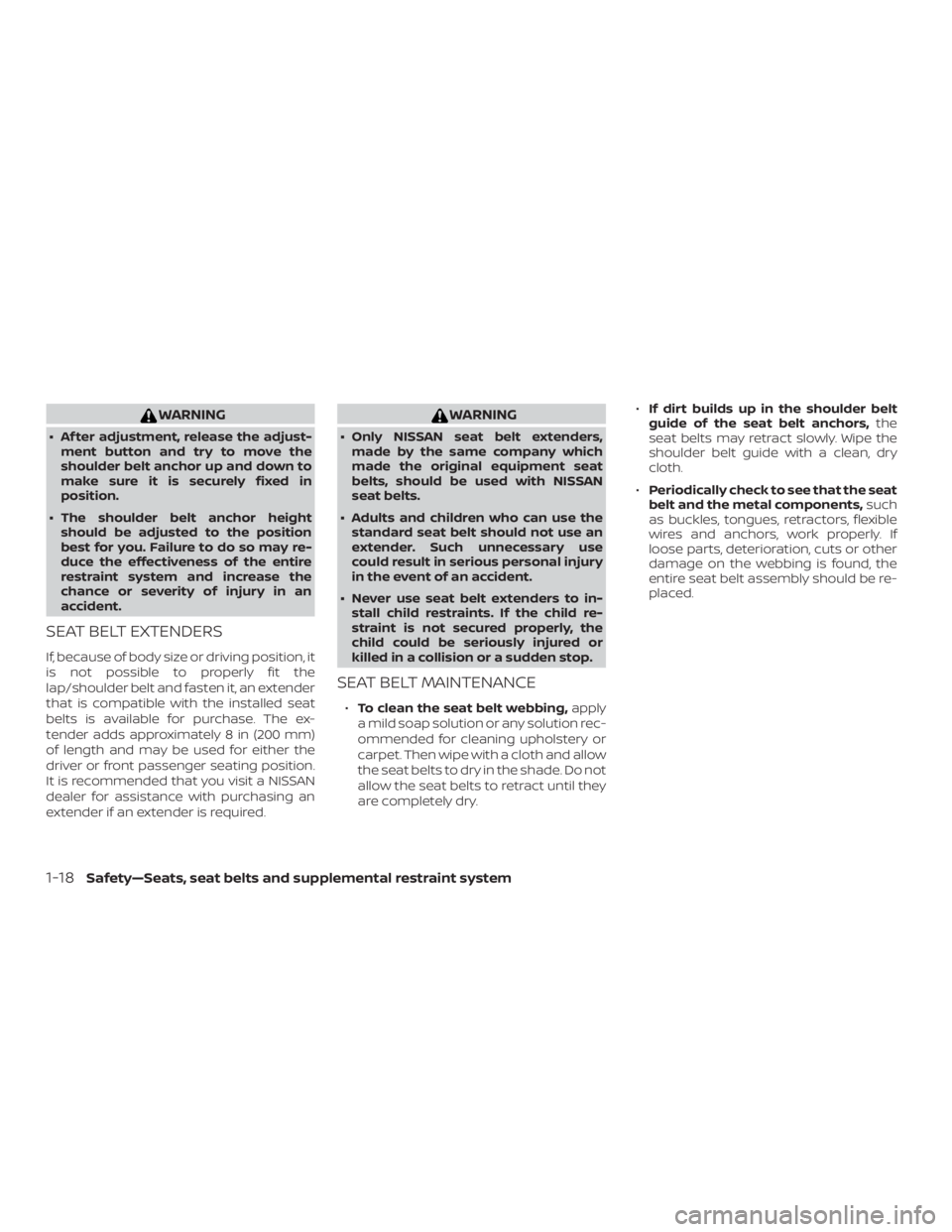
WARNING
∙ Af ter adjustment, release the adjust-ment button and try to move the
shoulder belt anchor up and down to
make sure it is securely fixed in
position.
∙ The shoulder belt anchor height should be adjusted to the position
best for you. Failure to do so may re-
duce the effectiveness of the entire
restraint system and increase the
chance or severity of injury in an
accident.
SEAT BELT EXTENDERS
If, because of body size or driving position, it
is not possible to properly fit the
lap/shoulder belt and fasten it, an extender
that is compatible with the installed seat
belts is available for purchase. The ex-
tender adds approximately 8 in (200 mm)
of length and may be used for either the
driver or front passenger seating position.
It is recommended that you visit a NISSAN
dealer for assistance with purchasing an
extender if an extender is required.
Page 153 of 300
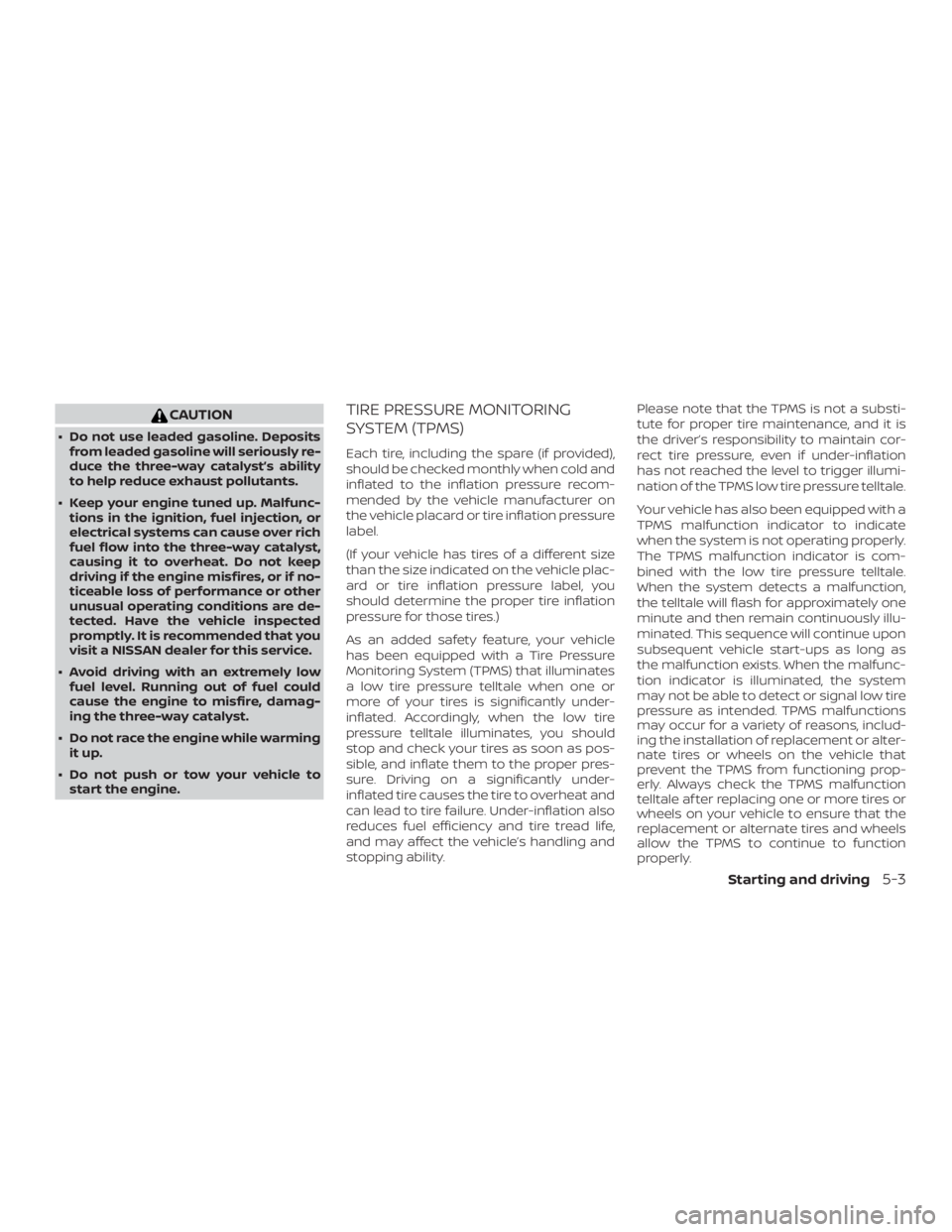
CAUTION
∙ Do not use leaded gasoline. Depositsfrom leaded gasoline will seriously re-
duce the three-way catalyst’s ability
to help reduce exhaust pollutants.
∙ Keep your engine tuned up. Malfunc- tions in the ignition, fuel injection, or
electrical systems can cause over rich
fuel flow into the three-way catalyst,
causing it to overheat. Do not keep
driving if the engine misfires, or if no-
ticeable loss of performance or other
unusual operating conditions are de-
tected. Have the vehicle inspected
promptly. It is recommended that you
visit a NISSAN dealer for this service.
∙ Avoid driving with an extremely low fuel level. Running out of fuel could
cause the engine to misfire, damag-
ing the three-way catalyst.
∙ Do not race the engine while warming it up.
∙ Do not push or tow your vehicle to start the engine.
TIRE PRESSURE MONITORING
SYSTEM (TPMS)
Each tire, including the spare (if provided),
should be checked monthly when cold and
inflated to the inflation pressure recom-
mended by the vehicle manufacturer on
the vehicle placard or tire inflation pressure
label.
(If your vehicle has tires of a different size
than the size indicated on the vehicle plac-
ard or tire inflation pressure label, you
should determine the proper tire inflation
pressure for those tires.)
As an added safety feature, your vehicle
has been equipped with a Tire Pressure
Monitoring System (TPMS) that illuminates
a low tire pressure telltale when one or
more of your tires is significantly under-
inflated. Accordingly, when the low tire
pressure telltale illuminates, you should
stop and check your tires as soon as pos-
sible, and inflate them to the proper pres-
sure. Driving on a significantly under-
inflated tire causes the tire to overheat and
can lead to tire failure. Under-inflation also
reduces fuel efficiency and tire tread life,
and may affect the vehicle’s handling and
stopping ability. Please note that the TPMS is not a substi-
tute for proper tire maintenance, and it is
the driver’s responsibility to maintain cor-
rect tire pressure, even if under-inflation
has not reached the level to trigger illumi-
nation of the TPMS low tire pressure telltale.
Your vehicle has also been equipped with a
TPMS malfunction indicator to indicate
when the system is not operating properly.
The TPMS malfunction indicator is com-
bined with the low tire pressure telltale.
When the system detects a malfunction,
the telltale will flash for approximately one
minute and then remain continuously illu-
minated. This sequence will continue upon
subsequent vehicle start-ups as long as
the malfunction exists. When the malfunc-
tion indicator is illuminated, the system
may not be able to detect or signal low tire
pressure as intended. TPMS malfunctions
may occur for a variety of reasons, includ-
ing the installation of replacement or alter-
nate tires or wheels on the vehicle that
prevent the TPMS from functioning prop-
erly. Always check the TPMS malfunction
telltale af ter replacing one or more tires or
wheels on your vehicle to ensure that the
replacement or alternate tires and wheels
allow the TPMS to continue to function
properly.
Starting and driving5-3
Page 175 of 300
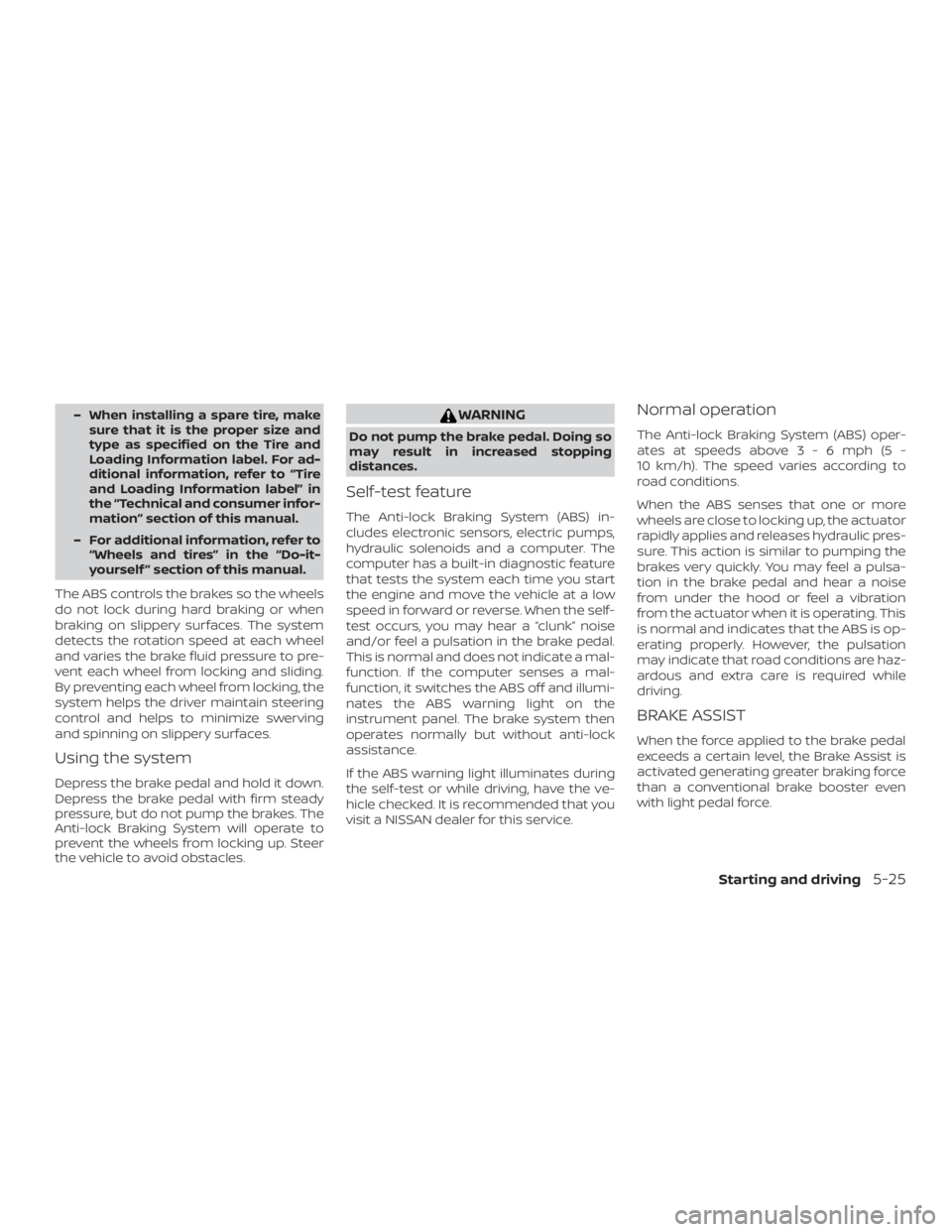
– When installing a spare tire, makesure that it is the proper size and
type as specified on the Tire and
Loading Information label. For ad-
ditional information, refer to “Tire
and Loading Information label” in
the “Technical and consumer infor-
mation” section of this manual.
– For additional information, refer to “Wheels and tires” in the “Do-it-
yourself ” section of this manual.
The ABS controls the brakes so the wheels
do not lock during hard braking or when
braking on slippery surfaces. The system
detects the rotation speed at each wheel
and varies the brake fluid pressure to pre-
vent each wheel from locking and sliding.
By preventing each wheel from locking, the
system helps the driver maintain steering
control and helps to minimize swerving
and spinning on slippery surfaces.
Using the system
Depress the brake pedal and hold it down.
Depress the brake pedal with firm steady
pressure, but do not pump the brakes. The
Anti-lock Braking System will operate to
prevent the wheels from locking up. Steer
the vehicle to avoid obstacles.
Page 184 of 300
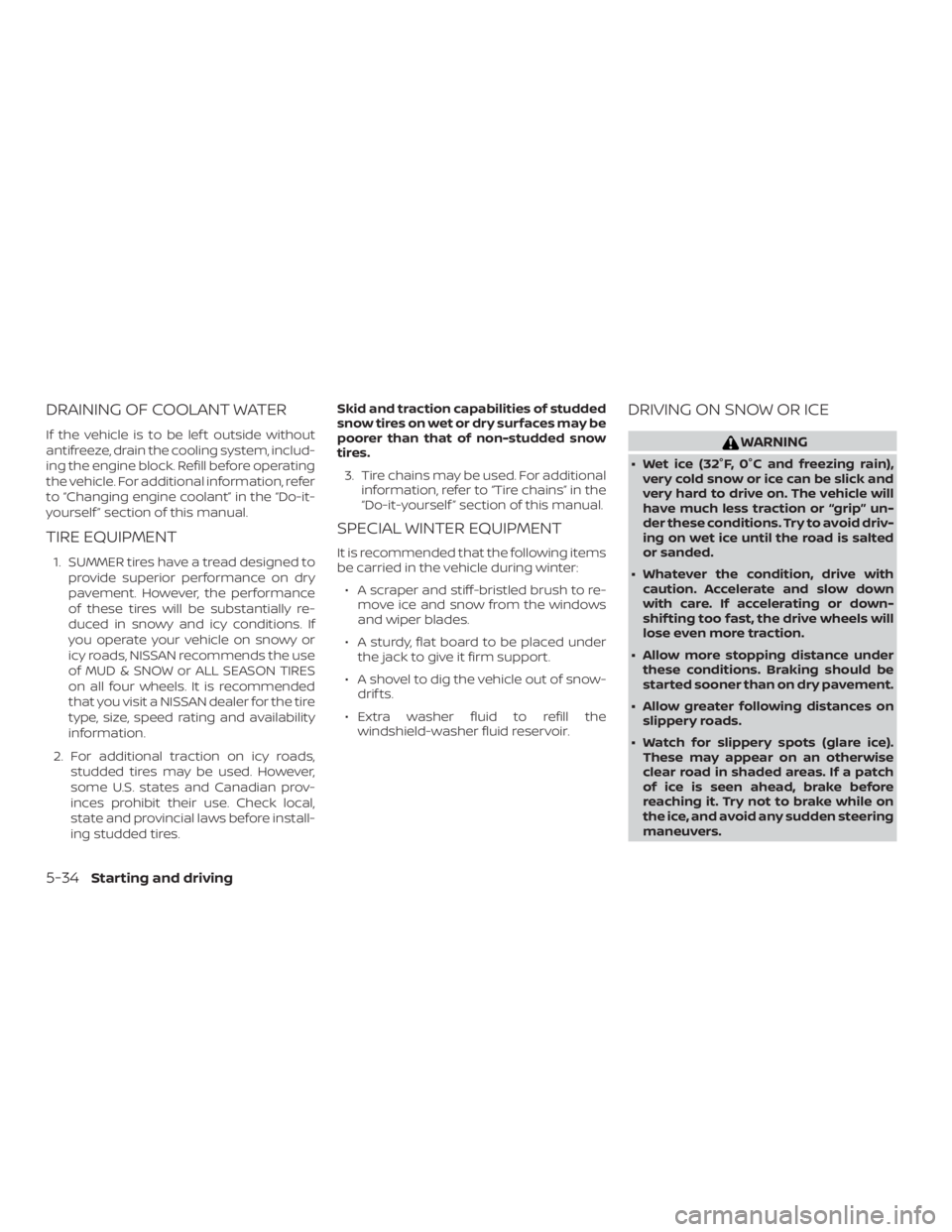
DRAINING OF COOLANT WATER
If the vehicle is to be lef t outside without
antifreeze, drain the cooling system, includ-
ing the engine block. Refill before operating
the vehicle. For additional information, refer
to “Changing engine coolant” in the “Do-it-
yourself ” section of this manual.
TIRE EQUIPMENT
1. SUMMER tires have a tread designed toprovide superior performance on dry
pavement. However, the performance
of these tires will be substantially re-
duced in snowy and icy conditions. If
you operate your vehicle on snowy or
icy roads, NISSAN recommends the use
of MUD & SNOW or ALL SEASON TIRES
on all four wheels. It is recommended
that you visit a NISSAN dealer for the tire
type, size, speed rating and availability
information.
2. For additional traction on icy roads, studded tires may be used. However,
some U.S. states and Canadian prov-
inces prohibit their use. Check local,
state and provincial laws before install-
ing studded tires. Skid and traction capabilities of studded
snow tires on wet or dry surfaces may be
poorer than that of non-studded snow
tires.
3. Tire chains may be used. For additional information, refer to “Tire chains” in the
“Do-it-yourself ” section of this manual.
SPECIAL WINTER EQUIPMENT
It is recommended that the following items
be carried in the vehicle during winter:
∙ A scraper and stiff-bristled brush to re- move ice and snow from the windows
and wiper blades.
∙ A sturdy, flat board to be placed under the jack to give it firm support.
∙ A shovel to dig the vehicle out of snow- drif ts.
∙ Extra washer fluid to refill the windshield-washer fluid reservoir.
DRIVING ON SNOW OR ICE
Page 250 of 300
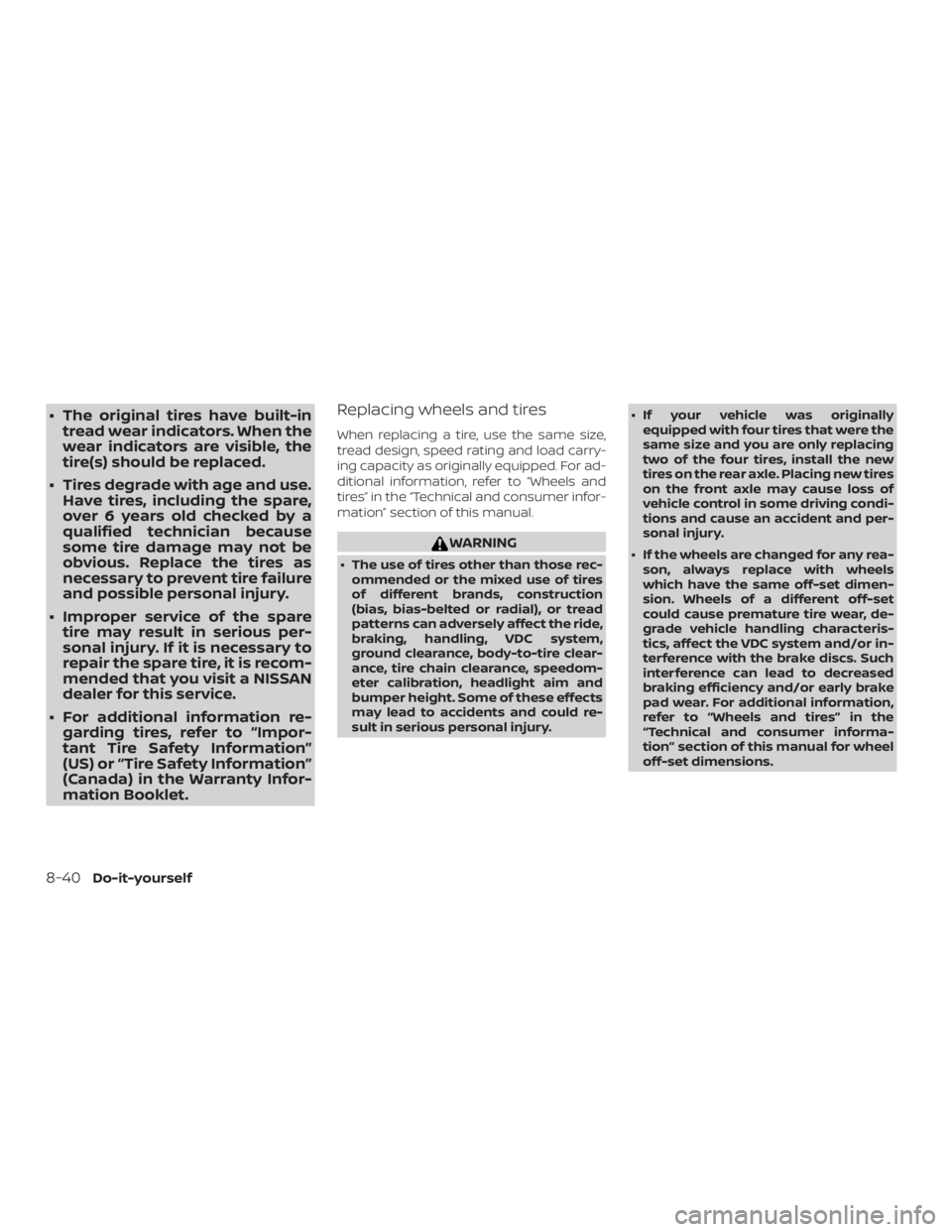
∙ The original tires have built-intread wear indicators. When the
wear indicators are visible, the
tire(s) should be replaced.
∙ Tires degrade with age and use. Have tires, including the spare,
over 6 years old checked by a
qualified technician because
some tire damage may not be
obvious. Replace the tires as
necessary to prevent tire failure
and possible personal injury.
∙ Improper service of the spare tire may result in serious per-
sonal injury. If it is necessary to
repair the spare tire, it is recom-
mended that you visit a NISSAN
dealer for this service.
∙ For additional information re- garding tires, refer to “Impor-
tant Tire Safety Information”
(US) or “Tire Safety Information”
(Canada) in the Warranty Infor-
mation Booklet.Replacing wheels and tires
When replacing a tire, use the same size,
tread design, speed rating and load carry-
ing capacity as originally equipped. For ad-
ditional information, refer to “Wheels and
tires” in the “Technical and consumer infor-
mation” section of this manual.
Page 293 of 300

Seat belt extenders............1-18
Seat belt maintenance ..........1-18
Seatbelts................1-11, 7-6
Shoulder belt height adjustment . . . .1-17
Three-pointtypewithretractor.....1-14
Seat belt extenders ..............1-18
Seatbeltwarninglight.........1-14, 2-14
Seats Adjustment ..................1-2
Frontseats..................1-2
Manual front seat adjustment ......1-3
Seats/floormats................7-5
Security indicator light ............2-17
Security system (NISSAN Vehicle Immobilizer
System), engine start ..........2-19,5-9
Security systems Vehicle security system .........2-18
Self-adjustingbrakes.............8-17
Service manual order form .........10-22
Servicing air conditioner ...........4-19
Shif ting Continuously Variable Transmission
(CVT) .....................5-14
Shoulder belt height adjustment ......1-17
Sliding door Manual sliding door .............3-7
Sonar Rear system ................5-29
Spark plug replacement ...........8-15
Spark plugs ...................8-15
Specifications .................10-8
Speedometer ..................2-4
SRS warning label ...............1-49
Stability control ................5-26
Standard maintenance ..........9-7,9-8 Starting
Before starting the engine ........5-10
Jumpstarting ............6-10,8-13
Precautions when starting and
driving.....................5-2
Push starting ................6-12
Starting the engine ............5-10
Starting the engine ..............5-10
Steering Power steering system ..........5-23
Stoplight....................8-28
Storage.....................2-28 D-ring ....................2-30
Storagetray...............2-28,2-29
Sunvisors....................3-17
Supplemental air bag warning labels . . .1-49
Supplemental air bag warning
light.................... .1-50, 2-14
Supplemental front impact air bag
system ..................... .1-39
Supplemental restraint system Information and warning labels . . . .1-49
Precautions on supplemental restraint
system ................... .1-32
Supplemental restraint system
(Supplemental air bag system) .......1-32
Switch Automatic power window switch . . .2-32
Hazard warning flasher switch ......6-2
Headlight and turn signal switch ....2-23
Headlightcontrolswitch.........2-23
Ignition switch ................5-8
Instrument brightness control .....2-24
P
ower door lock switch ..........3-6
Rear sonar system OFF switch .....2-26Rear window and outside mirror
defrosterswitch..............2-22
Turn signal switch
.............2-25
T
Tachometer ...................2-6
Thef t (NISSAN Vehicle Immobilizer System),
engine start ................2-19,5-9
Three-waycatalyst...............5-2
Tire Flattire..................6-2,6-3
Spare tire ...................6-4
Tire and Loading Information label . .10-11
Tire chains .................8-38
Tirepressure.............8-31,8-31
Tirerotation ................8-38
Typesoftires................8-37
Uniform tire quality grading ......10-18
Wheels and tires ...........8-31,10-9
Wheel/tire size ...............10-9
Tire pressure Lowtirepressurewarninglight.....2-12
Tire Pressure Monitoring System (TPMS) . .5-3
Tire warning label ...............10-12
Toptetherstrapchildrestraint.......1-23
Towing 4-wheel drive models ...........6-14
Flattowing.................10-17
Towtrucktowing .............6-13
Trailertowing ...............10-17
Towingatrailer................10-17
Transmission Continuously Variable Transmission
(CVT) fluid ..................8-10
11-5
Page 294 of 300
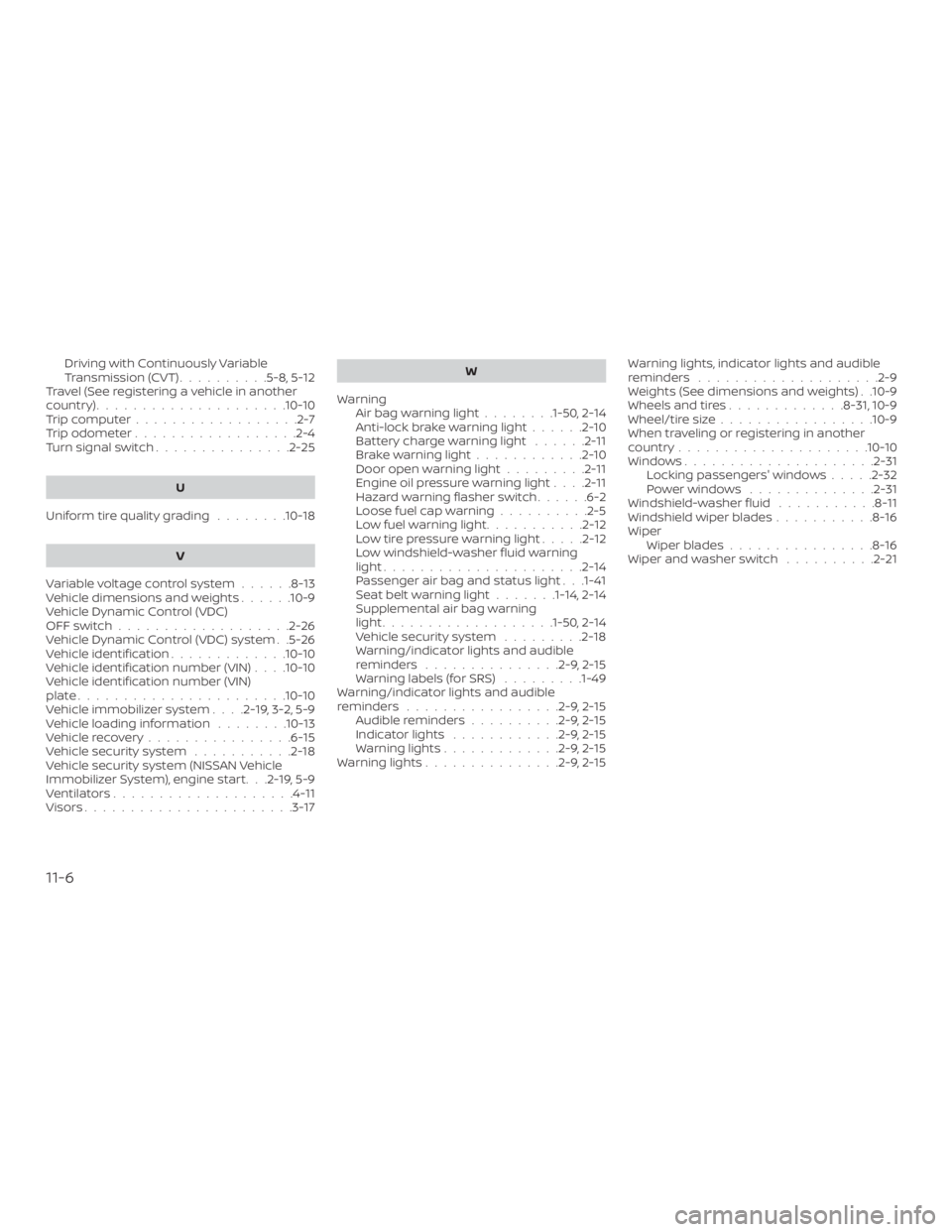
Driving with Continuously Variable
Transmission (CVT)..........5-8,5-12
Travel (See registering a vehicle in another
country) .....................10-10
Trip computer ..................2-7
Trip odometer ..................2-4
Turn signal switch ...............2-25
U
Uniform tire quality grading ........10-18
V
Variable voltage control system ......8-13
Vehicle dimensions and weights ......10-9
Vehicle Dynamic Control (VDC)
OFFswitch...................2-26
Vehicle Dynamic Control (VDC) system . .5-26
Vehicle identification .............10-10
Vehicle identification number (VIN) . . . .10-10
Vehicle identification number (VIN)
plate.......................10-10
Vehicle immobilizer system ....2-19,3-2,5-9
Vehicle loading information ........10-13
Vehiclerecovery................6-15
Vehicle security system ...........2-18
Vehicle security system (NISSAN Vehicle
Immobilizer System), engine start. . .2-19, 5-9
Ventilators ....................4-11
Visors.......................3-17 W
Warning Airbagwarninglight........1-50, 2-14
Anti-lock brake warning light ......2-10
Battery charge warning light ......2-11
Brakewarninglight............2-10
Door open warning light .........2-11
Engine oil pressure warning light ....2-11
Hazard warning flasher switch ......6-2
Loose fuel cap warning ..........2-5
Lowfuelwarninglight...........2-12
Low tire pressure warning light .....2-12
Low windshield-washer fluid warning
light......................2-14
Passenger air bag and status light . . .1-41
Seatbeltwarninglight.......1-14, 2-14
Supplemental air bag warning
light.................. .1-50, 2-14
Vehicle security system .........2-18
Warning/indicator lights and audible
reminders ...............2-9,2-15
Warning labels (for SRS) .........1-49
Warning/indicator lights and audible
reminders .................2-9,2-15
Audible reminders ..........2-9,2-15
Indicatorlights ............2-9,2-15
Warninglights.............2-9,2-15
Warninglights...............2-9,2-15 Warning lights, indicator lights and audible
reminders
....................2-9
Weights (See dimensions and weights) . .10-9
Wheels and tires .............8-31,10-9
Wheel/tire size .................10-9
When traveling or registering in another
country .....................10-10
Windows.....................2-31 Locking passengers' windows .....2-32
Powerwindows ..............2-31
Windshield-washer fluid ...........8-11
Windshield wiper blades ...........8-16
Wiper Wiper blades ................8-16
Wiper and washer switch ..........2-21
11-6